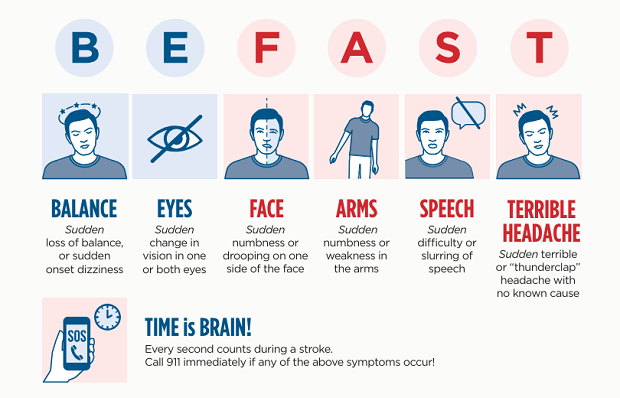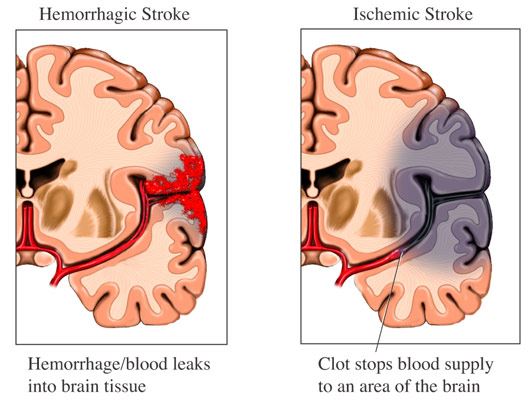Stroke
Every 40 seconds, someone in the United States has a stroke. Do you know the signs of stroke and what to do in case of an emergency? Learn the acronym BE FAST (balance, eyes, face, arm, speech, time) to remember the signs of stroke. Hear Roger Cheng, MD, a Neurointensivist at Robert Wood Johnson University Hospital and Assistant Professor of Neurology at Rutgers Robert Wood Johnson Medical School, explain BE FAST and what you should do if someone near you is having a stroke.
BE FAST to Know and Remember the Signs of Stroke
Stroke is a serious medical condition and requires immediate medical attention. The acronym B.E. F.A.S.T. is an easy way to remember and identify the most common symptoms of a stroke and the quick reaction that is necessary.
- Balance – Have you lost your balance, felt a sudden headache or "thunderclap" headache, or felt dizzy?
- Eyes – Is your vision blurry?
- Face – Is one side of the face numb or drooping? Is it possible to smile?
- Arm – Do you have feeling in both arms? Can you raise them both up without one drifting down?
- Speech – Can you speak with slurring words? Are you able to form coherent sentences?
- Terrible Headache – Sudden terrible or ‘thunderclap’ headache with no known cause
- Time – Every second counts during a stroke. Call 911 immediately if any of the above symptoms occur.

Some other symptoms of a stroke include memory loss and fatigue. You have higher stroke risk factors if you drink excessively, smoke, have hypertension, or have been diagnosed with diabetes. It is difficult to see a stroke coming, so learning your risk factors is very important for preventing long-term stroke damage.
It is also important to note that family and friends are usually the first to notice these symptoms and not the individual. Recognition of these symptoms will determine how quickly someone will receive help and treatment.
A stroke is a “brain attack.” It can happen to anyone at any time. It occurs when blood flow to an area of the brain is cut off due to a blood clot. When this happens, brain cells are deprived of oxygen and cells begin to die. When brain cells die during a stroke, abilities controlled by that area of the brain such as memory and muscle control are lost.
Types of Stroke
How a person is affected by their stroke depends on where the stroke occurs in the brain and how much the brain is damaged. The types include:
- Ischemic Stroke: The most common type of stroke. This type of stroke occurs when a blood vessel that takes blood to your brain gets blocked.
-
Hemorrhagic Stroke: This type of stroke occurs when a blood vessel in your brain balloons up
and bursts or a weakened one leaks. It's less common than an ischemic
stroke but can be more serious. There are two types of hemorrhagic stroke:
- Intracerebral: This is the most common type of hemorrhagic stroke. Occurs when an artery in the brain bursts and leads to the flooding of the surrounding tissue with blood.
- Subarachnoid: This is the least common type of hemorrhagic stroke. Occurs when there is bleeding in the area between the brain and the thin tissues that cover it.
- Transient Ischemic Attack (TIA)

Medical Illustration Copyright © 2019 Nucleus Medical Media, All rights reserved.
Causes of Stroke
A stroke is caused by blockage of blood flow. However, certain conditions, traits or habits may also raise your risk for stroke. These conditions are known as risk factors and include:
Non-Modifiable Risk Factors: These factors are irreversible and cannot be changed. The more of these risk factors you have, the greater your chance of stroke.
- People of all ages can be affected but the older you are, the greater your risk.
- Women have a higher lifetime risk of stroke than men do.
- Family history/Genetics
- African Americans and non-white Hispanic Americans are at higher risk than any other group in the U.S.
- History of strokes
Modifiable Risk Factors: These factors can be modified, treated or controlled through medications or lifestyle changes.
- High blood pressure
- High cholesterol
- Little to no physical activity.
- Diabetes: When your blood glucose, also called blood sugar, is too high.
- Excessive drug or alcohol abuse over many years.
- Obesity or having a body mass index “BMI” of 30 or greater.
Other conditions that contribute to stroke:
- Carotid artery disease
- Atrial fibrillation
- Obstructive Sleep Apnea: A condition in which your breathing abruptly stops and starts while sleeping.
- Certain blood disorders (i.e. anemia, hemophilia, blood clots, and blood cancer, leukemia, lymphoma, and myeloma).
Symptoms of Stroke
The length of time since first noticing any of the symptoms will be very crucial to note. This length of time can affect your treatment options. Besides the F.A.S.T symptoms, other common symptoms include:
- Sudden numbness or weakness of face, arm, or leg.
- Sudden confusion, trouble speaking or understanding speech.
- Sudden trouble seeing in one or both eyes.
- Sudden trouble walking, dizziness, loss of balance or coordination.
- Sudden severe headache.
Diagnosis of Stroke
It’s critical to diagnose a stroke in progress because the treatment for stroke depends on the type of stroke, and, in some cases, the location of the injury to the brain. Other conditions with similar symptoms to stroke and transient ischemic attack (TIA) will need to be ruled out to diagnose stroke. In order to do so, your doctor may do the following diagnostic tests:
Treatment of Stroke
Depending on the cause of your stroke, there are several treatment options:
Medication for Ischemic Stroke
- There is only one Food & Drug Administration (FDA) approved drug treatment for acute ischemic stroke. Tissue plasminogen activator (tPA) is given via intravenous therapy (IV) and works by dissolving the clot and improving blood flow to the part of the brain being deprived of blood flow. tPA should be given within three hours (and up to 4.5 hours in certain eligible patients) of the time symptoms first started.
Medical and Surgical Procedures for Ischemic Stroke
Medical and Surgical Procedures for Hemorrhagic Stroke
The first steps in treating a hemorrhagic stroke are to find the cause of bleeding in the brain and then control it. Some of the options for treatments include:
